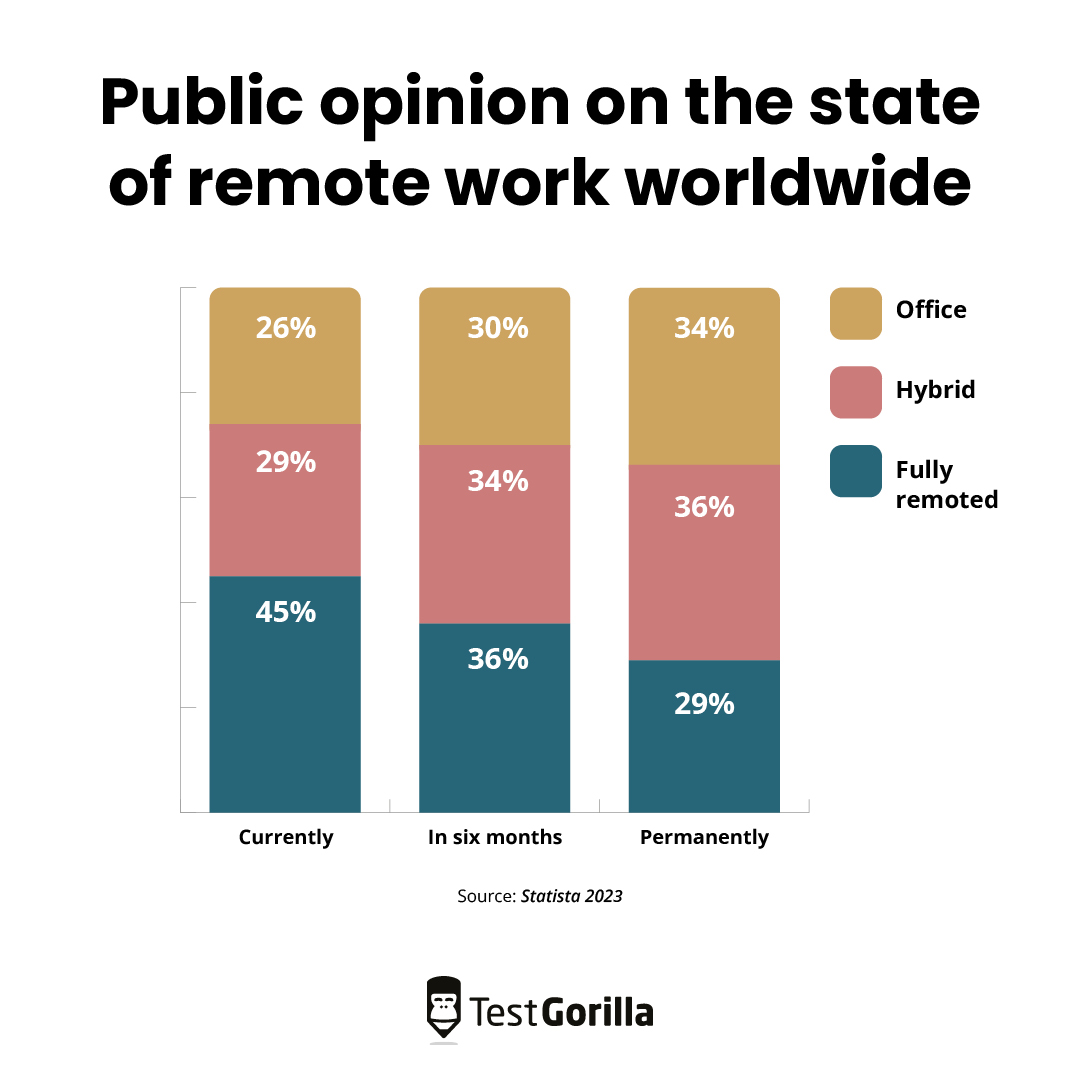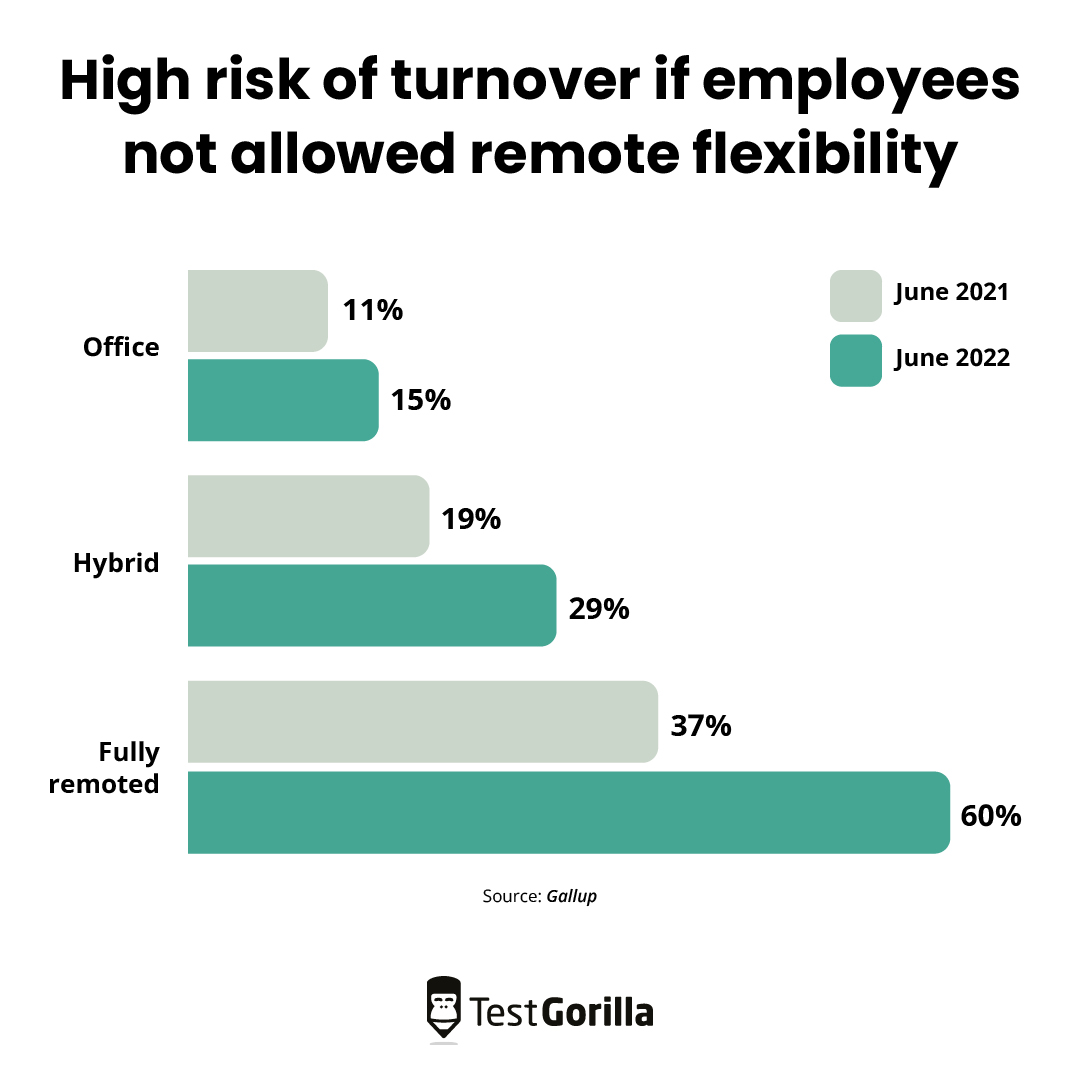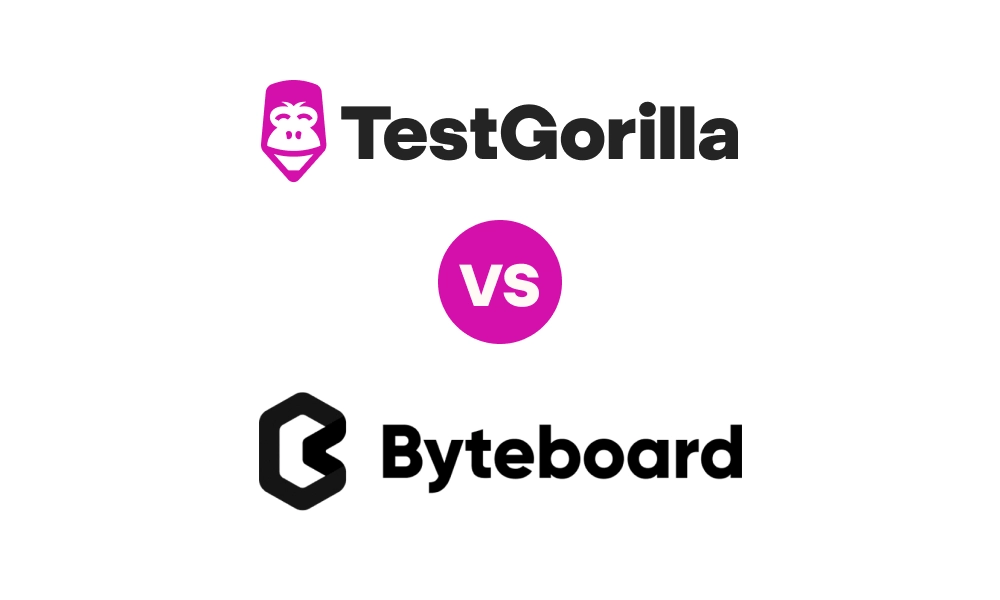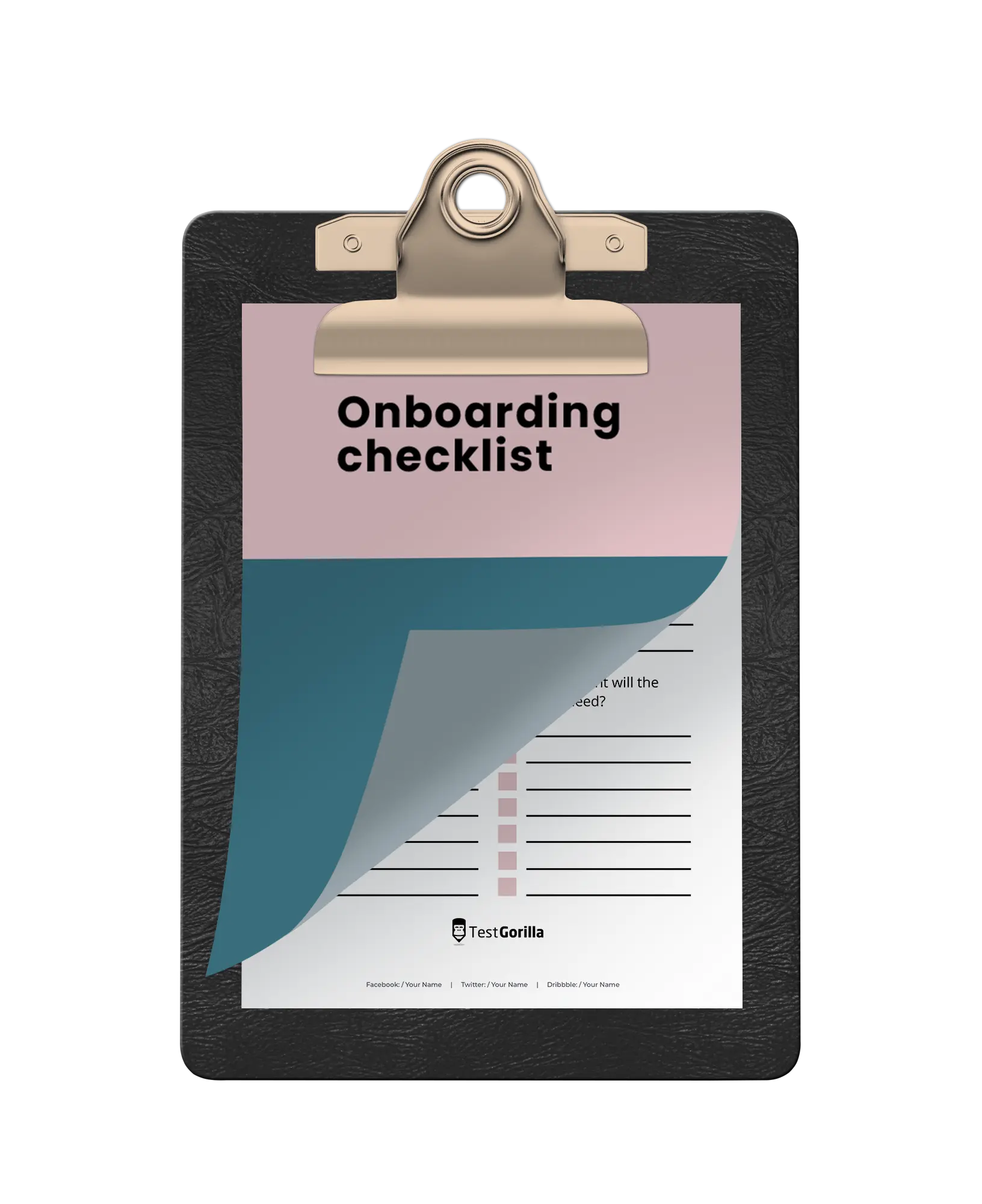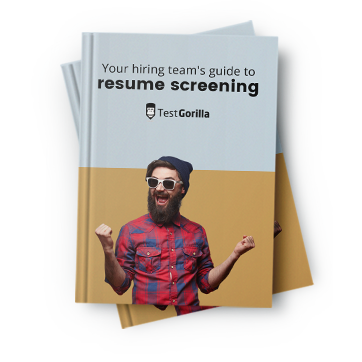Returning to the office means switching back onsite after working remotely on a mass scale during the pandemic.
Whether or not it’s the right move is a raging debate in 2023, and it’s (uselessly) creating a divide between employers and employee expectations in an already challenging period.
Do employees want to return to the office? How do remote, hybrid, and onsite arrangements compare now that we’ve had some time to test the waters?
Is there a way to please both sides?
We have a firm stance on the situation – and it’s remote first.
But first, let’s walk you through the return to office arguments and the surrounding facts so you can see both sides of the discussion and decide what’s best for your company.
Table of contents
- Why is the return to office debate raging now?
- 6 arguments made by supporters of the return to office movement
- 9 counter-arguments made by supporters of remote and hybrid working
- The TestGorilla perspective: Remote and hybrid working arrangements are the future of work
- Return to office isn’t the solution; flexibility is
- Sources
Why is the return to office debate raging now?
As we’re getting further away from the Covid-19 outbreak peaks, companies and employees can’t agree on the best way to proceed with return-to-office policies.
Should we go back to the offices as though Covid didn’t happen? Should we keep up the changes we originally adopted for the quarantine mandates? Or could we pursue a mix of both, adjusted for the circumstances of 2023 and on?
Here’s where things stand right now:
Despite the viral news about certain companies like Apple, Disney, and Twitter flipping the switch on their employees, only 5% of chief executive officers in the US and 2% in Europe consider returning to the office a high priority right now.
Countries with advanced economies like the UK, Germany, the US, Japan, France, and Spain can sustain more remote workers than their emerging counterparts.
Statista’s survey shows that the majority of employees are still working remotely, but the situation is likely to change more toward in-person work in the future.
On the employee’s side of things, Gallup’s research shows how the 56% of staff (70+ million workers) whose job can be done from home are working as of June 2022:
The research sheds light on the remote-capable staff status:
2 in 10 employees are currently working from the office
3 in 10 are working remotely
5 in 10 employees work remotely and come to the office a few days per week
60% of employees prefer a hybrid work setting
Importantly, when an employee’s location preference doesn’t match their current arrangement, engagement drops, wellbeing levels are lower, and burnout rises.
The more flexibility they currently have, the more likely employees are to leave if that flexible work is revoked at any point.
But remote work isn’t equally applicable to all employees and industries.
The top industries where remote work is supported according to insights from FlexJobs in 2023 include:
Computer & IT
Marketing
Accounting & Finance
Project Management
Medical & Health
HR & Recruiting
Customer Service
To put it simply, any occupation that spends most of the time on remote-friendly tasks like inputting information, processing and analyzing, creative thinking, administration, and communication with colleagues or clients is qualified to be at least hybrid work.
This rules out some employees automatically – waiters, construction workers, nurses, and surgeons, to name a few.
But the majority of employees qualify for remote work at least part of the time.
The question is, is there a good reason to demand they return to the office anyway?
6 arguments made by supporters of the return to office movement
All sides deserve a chance to explain their reasoning and prove their points.
So, let’s see all the arguments the office advocates are making.
Summary of the arguments in favor of returning to office
The quick rundown:
Productivity is higher in the office
It’s easier to monitor and manage employees
It’s linked to better employee recognition
Results in stronger workplace culture and more opportunities for coaching or mentoring
Increases levels of creativity and collaboration
Leads to a better work-life balance
Make sure to read the sections below because – spoiler alert – some of these arguments are flawed.
1. Productivity is higher in the office
This is a belief held by many managers and leaders.
But it’s not true.
In fact, a lot of research says the opposite: Remote workers report higher productivity and often spend more time working, too.
It’s important to distinguish productivity from appearing busy.
Employees who have to return to office and work at set times do so for better or for worse. They don’t get to choose the time that suits them best, which is a shame because you could be losing out on their peak productivity times.
A caregiver who’s worrying about their family member home alone during work hours won’t be clocking in their best hours.
Neurodivergent employees might be debilitated by the office environment itself – the bright neon lights, the click-clack of surrounding keyboards, or their coworkers’ perfume could be far more overstimulating than their at-home work environment.
They have to put all their effort into managing the situation to avoid a meltdown or shutdown when they could be in a controlled and comfortable environment at home, focusing on the work in front of them instead.
Instituting a return to office plan could be setting your staff to fail.
Why not support employee wellbeing and get the best out of them by letting them work in their own hours and locations at least some of the time?
2. It’s easier to monitor and manage employees
Face-to-face work is the way we’ve always done it. It’s the employer’s comfort zone to be able to observe their team in the flesh.
But it’s not the only way you can monitor and manage employees successfully.
Managers might think that having employees in front of them ensures that they can spot bottlenecks or notice when somebody is slacking off.
However, this doesn’t guarantee higher productivity (and can even backfire) for three reasons:
Employees who feel like they can’t be seen not working without risking getting additional assignments might feel pressured to pretend they’re busy
Productivity bottlenecks might go under the radar because you’re focusing on the wrong things
Gawking over everyone’s desks isn’t the best use of a manager’s time, anyway
At the end of the day, what you want to be prioritizing are the processes, outcomes, and communication with employees – all of which can be done remotely.
3. It’s linked to better employee recognition
Out of sight is out of mind, right?
If you think “routinely working long hours” and “showing up for work no matter what” are criteria for good recognition, what you’re promoting may be just presenteeism.
You’ve seen it: when employees come to work sick purely out of obligation, unable to be productive. You’ve probably even been there at some point in your life.
The problem still exists with remote work, but forcing employees to move to sterile offices from the comfort of their own home only makes things worse.
The true problem lies with the recognition system and what employers value.
When you look at skills, outcomes, and contributions, you get a more accurate picture of how the busiest people aren’t necessarily the most productive among your employees.
Over time, when you switch to these metrics instead of focusing on who’s online the most or shows up when they’re burnt out, you can really find the high performers and appreciate them as such – remotely or in office, as long as the policy is clear.
Not to say you should ignore people who are trying by working long hours.
Appreciate the sentiment, but shift the focus and teach them how to use that energy in more productive ways.
You should consistently model the correct behavior, reward true high performance, and guide employees to focus on the things that are most valuable to the company instead.
That way, everyone knows what high performance looks like and what kind of “extra mile” is most appreciated should they want to go for it, remotely or not.
Recognition and employee appreciation can be expressed remotely as well as in the office, either privately or in a group chat for public recognition so other employees can learn and follow suit.
4. Results in stronger workplace culture and more opportunities for coaching or mentoring
Employees naturally and spontaneously socialize more when they’re surrounded by colleagues, which isn’t the case for remote workers who can’t even see their colleagues and lack opportunities to connect.
In the office, a mentor can easily answer questions as they arise and use those teachable moments to help employees do their best work.
But what if your employees are not in front of you?
Admittedly, this is one of the few valid arguments against remote work, but one you can overcome with a good plan, communication channels, positive culture, and frequent check-ins.
5. Increases levels of creativity and collaboration
Return to office might delight and inspire extroverts who are fueled by interactions with others.
Seeing colleagues in person also makes the collaboration quicker compared to going back and forth over Slack.
However, to say that creativity and collaboration increase across the board would be a stretch because this definitely isn’t the case for all employees. For example:
Type of employee | Their struggles with office work |
Neurodivergent employees | Can be easily distracted; Struggle with office chit-chat and social rules; Might need support they can’t access in the office (invisible disability is still disability) |
Working parents | Might worry about what’s happening at home while they have to be in the office; Might struggle to be present; Need help with child care |
People with disabilities | Might need more frequent breaks which they can’t take in the office; Fear being perceived as slacking’ Can’t complete their workload all at once, but can complete it in bursts |
At home, employees are able to pace themselves and show up when they can be most productive while having the custom accommodations or care they need.
Return to the office might be a refreshing change for some employees, but a lot of them might needlessly struggle way more.
Hybrid work is the best compromise here.
6. Leads to a better work-life balance
It’s easier to separate private life from work onsite compared to home offices where there’s not much stopping you from napping, eating, and working on the same couch.
Many employees report working longer hours remotely than they did in the office.
There’s this pressure to stay available for work-related communication at all times, and the lines between professional and personal are indeed blurred.
However, we need to consider all the factors.
Arguably, eliminating the commute, preparation time, and extra costs that come with traveling to the office offsets the work-life benefits above. Wouldn’t you be more willing to respond to emails in the evening if it means not spending an hour of your day commuting?
9 counter-arguments made by supporters of remote and hybrid working
Now let’s see the pro-remote and hybrid angle.
Full disclosure – TestGorilla is firmly in this camp as a 100% remote company.
Summary of pro-remote work arguments
Employees want to work in a flexible environment
Productivity levels are similar (or higher) than in-office
Leads to greater employee health due to a lack of stressful commuting and lower costs of living
Company culture can be cultivated and grown remotely
Hybrid working is an excellent compromise
Attracts more diverse applicants
Gives you access to wider talent pools
Recruiting tech tools have empowered skills-based hiring
Unhappy employees quit, or they “quiet quit” until economic conditions recover
1. Employees want to work in a flexible environment
Flexibility remains top of the agenda for candidates in 2023.
That includes flexibility in terms of:
Location (fully remote, hybrid schedule, or in-office)
Hours (synchronous, asynchronous, full-time, or part-time)
Millennials want remote work the most, but most employees want flexibility as an option, regardless of their generation.
Interestingly, Gen Z doesn’t mind working in the office part of the time, but they prioritize higher compensation and schedule flexibility as the top reasons for planning to quit.[1]
Women are more likely to prioritize companies that put DEI, employee wellbeing, and flexibility at the front, and young women are more likely to leave for a company that fits the bill.[2]
If there’s one thing all employees agree on, it’s that they want flexibility.
In other words, regardless of their personal preference in terms of location or schedule, employees want companies to give them the agency to choose their preferred work style.
2. Productivity levels are similar (or higher) than in-office
Productivity is alive and well in remote offices due to fewer distractions, a custom environment, no time wasted on the commute, and the ability to meet all needs while getting work done.
Employees who work from home save 72 minutes per day on average and allocate most of it to work.
And even if they spent that extra time with loved ones or blowing off steam, it’s a win-win for work-life balance no matter how you look at it.
But speaking of commuting…
3. Leads to greater employee health due to a lack of stressful commuting and lower costs of living
Commuting is a waste of time.
We know people who used to spend 45 minutes in both directions to and from work each day before going remote.
Think of the wasted time and the rising gas prices!
Aside from removing that daily hassle from employees’ lives, remote work opens doors to new possibilities which many people are embracing.
A popular perk is moving from major cities to suburban and rural areas.
This chance comes with a change of scenery and a lower cost of living, which means more time and money that staff can invest in their wellbeing and things that fulfill them.
4. Company culture can be cultivated and grown remotely
Sure, remote socializing isn’t as spontaneous as it is in person. Some elements you pick up about people simply aren’t there if you don’t see them.
But culture shouldn’t be left to chance anyway.
We can assure you that it’s possible to facilitate a positive culture remotely, even while wearing PJs at home.
The important part is that you’re encouraging and modeling overcommunication, promoting teamwork, and building company values into your recognition metrics.
This shows that culture is as important to your company as high-quality work.
It’s also smart to think about culture already when you’re hiring.
Hiring a person who shares your values from day 0 ensures they help you build the right kind of environment instead of disrupting it.
This is the value in hiring culture adds instead of culture fits.
And, a reminder: Working remotely doesn’t mean you’re not allowed to see each other ever.
That was just the pandemic, which is no longer in full swing.
TestGorilla makes sure to organize events for staff at least once a year – in 2022, we all met in Barcelona and spent lots of quality bonding time together.
5. Hybrid working is an excellent compromise
It’s not either/or. Some roles require employees to be in the office full-time, but that’s not the case for most employees.
For roles that require attendance and for companies that want to maintain some level of in-person contact with their employees, hybrid arrangements can be the perfect solution.
It’s the desired default setting among employees:
The real question is how to organize hybrid work.
That’s where we lack a clear consensus among employees: Should they have full autonomy over when they visit the office? Should the employer coordinate them? What about team interdependency?
Looking at the reasons why employees are choosing to spend some time in the office rather than going fully remote, it’s essential to ensure they feel connected and able to work together in a hybrid office model.
You may need to experiment a bit to find the intersection between the expectations of your staff and yourself.
The way we see it, it boils down to two factors:
Hybrid work factor | Why it matters |
1. Productivity | Employee productivity impacts your overall performance and profitability; If you’re not focusing on the right metrics, presenteeism can sneak up on you |
2. Employee satisfaction | Any setting goes out the window if it doesn’t match employees’ preferences; Productivity, engagement, and employee wellbeing hinge on satisfaction; The bottom line is |
If you can arrange that employees get to organize the way they want to and provide opportunities for them to socialize and connect, you would have a win-win.
Employees would be happy and doing a good job. Word would spread that you’re the employer to work for.
A real “happily ever after” for your company.
6. Attracts more diverse applicants (in all senses of the word)
Diverse applicants include all ethnicities, LGBTIA+ candidates, candidates with criminal records, visible and invisible disabilities, socioeconomic classes, and backgrounds.
Think they’re all automatically included in your company?
A mandatory cookie-cutter experience across the board says otherwise. Not all applicants in these groups can or will return to office-based work. They demand flexibility.
Why should that make you budge?
Because diversity is worth it.
It’s easy to keep hiring the same type of person. But you don’t need your company to become an echo chamber and stagnate when it could be propelled forward by innovative ideas and perspectives.
Culture adds are treasures. They can help you find the blindspots you never would have noticed and fix them.
You can use a Culture Add test to find such applicants.
But before you do that, it’s important you understand that with unique skill sets and experiences come different needs, too.
You can’t just capitalize on their strengths – be sure to welcome diverse candidates as whole humans and respect their differences. Companies should be willing and eager to accommodate diverse needs for diverse employees.
One of the best ways to both attract and retain diverse candidates is by offering flexibility.
7. Gives you access to wider talent pools
On the tails of the previous point, opening your doors to candidates who need flexible arrangements gives you a much wider talent pool to hire from.
Remote job ads attract seven times more applicants than other positions.
More options mean more high-quality candidates, leading to better hires for your company.
8. Recruiting tech tools have empowered skills-based hiring, which lets you hire top-quality talent remotely and across borders
Seeing how you no longer have to do recruiting onsite, remote and hybrid companies that embrace skills-based hiring have the first pick of top talent.
Consider this finding:
Out of employees who are satisfied with their jobs and report not being likely to leave, 65% say it’s because they like where they live.
However, among employees who recently took jobs in new cities, 90% didn’t have to relocate for the job.
The fact that more options are becoming available might get staff to second-guess their decision to stay put.
So, even if your employees are currently happy, if you’re stubbornly demanding onsite work, they might reconsider as soon as they need some flexibility that you aren’t giving them.
Want to keep them? Leave flexibility on the table.
9. Unhappy employees quit, or they “quiet quit” until economic conditions recover
Forcing policies on employees leads to job dissatisfaction, which leads to higher turnover and its consequences for you.
Even if they have to stick around for now, unhappy workers aren’t good for the business.
Motivated and engaged employees perform much better, contribute to a positive workplace environment, and drive higher profits with high-quality work.
Accommodating your staff so they would want to do more than the bare minimum is the least you can do to incentivize them.
The TestGorilla perspective: Remote and hybrid working arrangements are the future of work
Removing remote as an option across the board isn’t only “going back to the way things were,” it’s failing to acknowledge the problems that were there back then as well.
It’s exclusive, inefficient, and even ableist.
Companies that demand return to office are sending the message to disabled employees that they can’t accommodate them even though it’s possible.
Of course, shutting the door to a portion of the workforce isn’t anyone’s intention.
The fact remains that flexibility in terms of locations and hours isn’t negotiable to many candidates and employees:
Disabled candidates (1 in 4 Americans)
Working parents and caregivers
International talent (moving for the job could require extensive paperwork and a long time, or it might be impossible)
Travelers
Military spouses
Workplace flexibility is a top priority for candidates and employees, especially Gen Z and Millennials.
As for the rest of the workforce…
Even people who don’t themselves need or want to work remotely care about employee wellbeing, company culture, and diversity and inclusion, all of which are intrinsically tied to remote arrangements.
Forcing return to work on employees leads to some of them instantly dropping out because they can’t comfortably comply.
Out of those who can return to office, many experience decreased work satisfaction and quality of life, leading to higher psychological stress and lower quality work.
On a company level, this change increases your turnover rate.
Consequences that follow are the costs to replace employees and maintain your output, even more stress and burnout for remaining staff, a toxic workplace culture, and a poor employer brand affecting your ability to attract new quality talent.
This isn’t a situation we recommend.
So, should you ban in-office work entirely, then?
No – leaving hybrid and remote options on the table is the only way to go forward.
Return to office isn’t the solution; flexibility is
The return to office debate shouldn’t be much of a discussion – flexibility is the future, and it’s great for everyone involved.
Even if you’d like for employees to return to office, letting them choose the best type of arrangement for their situation promotes a healthier, inclusive culture and keeps workers engaged.
Maybe they still want to work from the office some (or all) of the time.
But the most important thing for you to focus on is creating systems that empower you to support employees and recruit new talent no matter where they are.
Tip: Pre-employment assessments come in handy for the hiring part.
Keep learning how to manage remote teams as effectively as you do onsite, and let the fear of remote work go.
Sources
Related posts
Hire the best candidates with TestGorilla
Create pre-employment assessments in minutes to screen candidates, save time, and hire the best talent.
Latest posts
The best advice in pre-employment testing, in your inbox.
No spam. Unsubscribe at any time.

Hire the best. No bias. No stress.
Our screening tests identify the best candidates and make your hiring decisions faster, easier, and bias-free.
Free resources
This checklist covers key features you should look for when choosing a skills testing platform
This resource will help you develop an onboarding checklist for new hires.
How to assess your candidates' attention to detail.
Learn how to get human resources certified through HRCI or SHRM.
Learn how you can improve the level of talent at your company.
Learn how CapitalT reduced hiring bias with online skills assessments.
Learn how to make the resume process more efficient and more effective.
Improve your hiring strategy with these 7 critical recruitment metrics.
Learn how Sukhi decreased time spent reviewing resumes by 83%!
Hire more efficiently with these hacks that 99% of recruiters aren't using.
Make a business case for diversity and inclusion initiatives with this data.

